Review: Anker PowerCore 20100
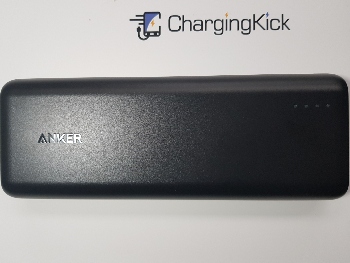
The Anker PowerCore 20100 is one of the most popular power banks sold and reviewed in recent years. What makes this power bank so popular? Is it the technology or its efficient battery? Read on to find out.
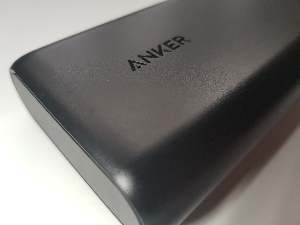
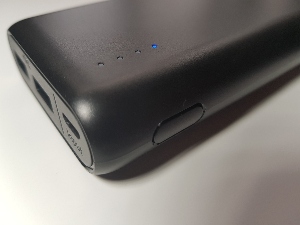
Pros & Cons:
Pros:
A big and efficient battery
Simultaneous charging of two devices
Amazing charging time of two devices at the same time
Relatively small and low-weight for its capacity
Cons:
It doesn’t charge all devices at their optimal speed
Lacks USB-C for input and output charging
Rating
Power & Performance (1 to 5 stars)
Design & Build (1 to 5 stars)
Technology (1 to 5 stars)
Overall Rating (average of above)
Key Product Specifications
Key Specs:
Capacity
20,100 mAh / 72.36 Wh
Dimensions (LxWxH)
6.5 x 2.4 x 0.9 in / 16.8 x 6.2 x 2.2 cm
Weight
12.7 oz / 359 g
Output & Input Charging:
Average Charging Time of a Mobile Phone (average battery capacity 3000mAh)
2 hours
Average Recharging Time (from 0% to 100%)
9 hours and 45 minutes
Ports
- 2 x UBS-A Output: 5V/2.4A (each)
- Micro USB Input: 5V/2A
Charging Technology
PowerIQ - fast charging technology
VoltageBoost - compensates for cable resistance by smoothing voltage output
MultiProtect safety system and high-quality LG battery cells ensure complete protection for you and your devices.
Flight Status
- Under 100WH
- Safe to take on board.
Other Features
18-Month Limited Warranty
Lifetime Technical Support
Ideal For?
Travelers
Adventurers
Businesspeople
What’s Inside?
Anker PowerCore 20100 Power Bank
Micro USB cable
Travel pouch
Welcome guide
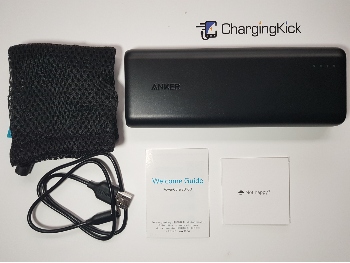
Power & Performance
Battery Capacity
Battery capacity in mAh and Watts
The Anker PowerCore 20100 has a battery capacity of 20,100 mAh / 72.36 Wh. This big battery enables it to charge most mobile phones around 5 times.
Capacity test: discharge the fully charged power bank
Have you ever wondered whether a power bank has its battery capacity? Does it really have 5,000 mAh or 10,000 mAh, as advertised? What is the real battery capacity?
To check the actual battery capacity we need:
The fully charged power bank
A USB tester that shows the current, voltage, mAh, and charging time.
The USB mini adjustable load receives energy from the power bank and releases it safely via the fan. This is the safe way to discharge a fully charged power bank and measure the real battery capacity.
I connect the dummy load (amperes are set to 2) to the USB tester, then plug it into the fully charged power bank. Once that’s done, I wait until the power bank’s battery goes flat. The screen on the USB tester will display the Watt-hours and the amount of mAh consumed. These data show the real battery capacity.
Using the aforementioned procedure, I tested the Anker PowerCore 20100. Here are the results:
Capacity Test
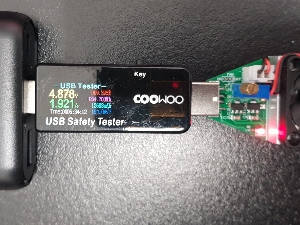
Results:
Discharge Time - 6 hours and 34 minutes
Watt-Hours - 64.7 Wh
Ampere hour - 12,608 mAh
The real battery capacity is 12,608 mAh. This mAh measurement shows you the energy you will fully use to charge your mobile phone. It’s not 20,100 mAh because the unit is converting energy from 3.7V (the power bank’s battery voltage) to 5V (USB voltage). This loss occurs in every power bank.
When you know the advertised and real battery capacity, it’s possible to measure the battery efficiency, which in this case is 85%. Manufacturers frequently don’t share this information. Efficiency above 90% is considered very good. With 85% of battery efficiency, the Anker PowerCore 20100 is a decent battery, about the average.
Disclaimer: Every test can produce different results, but only small variations.
How many times can you charge the most popular mobile phones in 2020?
To put the battery capacity into perspective, I will use a formula for Real Battery Capacity and calculate how many times the Anker PowerCore 20100 can charge the top 10 most popular mobile phones in 2020. Perhaps you own one of them, or at least you know your mobile phone’s battery capacity.
From the previous test, we know the real battery capacity is 12,608 mAh.
Once we know the real battery capacity, we simply divide it by the enlisted mobile phones’ battery capacity to find out how many times it can be charged.
Mobile Phone Model | How Many Times Can It Be Charged? |
4.61 | |
3.05 | |
2.88 | |
2.88 | |
3.24 | |
7.13 | |
2.88 | |
4.13 | |
3.09 | |
2.60 |
The Anker PowerCore 20100 is a voluminous power bank that can charge the biggest mobile phones at least twice, closer to 3 times. With an average phone with a battery of 3,000 mAh, you’ll get at least 4 full charges. This power bank is for high usage and/or trips without easy access to civilization, and therefore to electricity.
Output Charging
Charging Time & Power Usage
Power banks are used mainly to charge devices. Therefore, this review would not be completed without testing output charging. For this, knowledge of the device’s charging time is crucial. Frequently it is one of the most important factors in the purchase of a power bank.
For these tests, I used two mobile phones:
Huawei P10 with a battery of 3200 mAh (Huawei SuperCharge)
Samsung S8 with a battery of 3000mAh (Adaptive Fast Charging)
Both phones support fast-charging technology.
To record data (current, voltage, mAh, time) I used a USB tester.
Real-life examples of test-charged phones demonstrate what you can expect after purchasing a power bank.
The Anker PowerCore 20100 has two output USB-A ports that deliver a total output of 4.8 amps (2.4 amps each). It also has PowerIQ, an Anker technology that optimizes charging speeds. That said, this power should be enough to charge most mobile phones at a rate of 5V/2A or even higher. Potentially it should charge two phones simultaneously at this rate as well. But this is only theory, backed up by calculations. But how good is it in reality? Let’s find out.
Charging via USB-A (Huawei)
%20-%20Finish.jpg?alt=media&token=1dc740c9-ecb9-493f-b4de-4c5f624e750d)
It took 2 hours and 25 minutes to charge the Huawei P10 – way longer than expected. The charging speed was at 5V/1.2A, only half of the power bank’s capability. When I used the cable that comes with the Huawei’s charger, the power bank sped up to 5V/2A. I found this bizarre. Nonetheless, Anker is proud of its PowerIQ system, which automatically detects optimal charging speeds, so changing a cable shouldn’t be the thing that provides the highest charging speed. The power bank delivered a total of 2,448 mAh / 12.5 Wh.
Charging via USB-A (Samsung)
%20-%20Finish.jpg?alt=media&token=5957828f-3bd8-4706-afb0-feb4ee124603)
It took 1 hour and 35 minutes to charge the Samsung S8, a much better time than the Huawei’s test. This meets expectations. The charging speed averaged 5V/1.8A. The power bank delivered 2,095 mAh / 10.8 Wh in total.
Charging two phones simultaneously
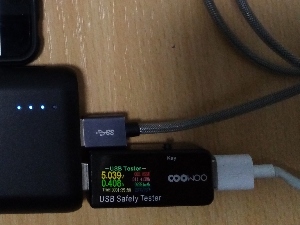
Due to the layout of the ports, I couldn’t use two testers at the same time, so my data is not fully accurate. The power bank needed 1 hour and 40 minutes to fully charge both phones. This is an amazing time, and it seems the power bank used its full charging power. It delivered approximately 4,200 mAh / 21 Wh of energy.
A roundup of output charging
Essentially, Anker PowerCore 20100 has great output charging abilities. It had an issue with the Huawei P10, but changing the cable helped. That shouldn’t happen, but it’s acceptable. The simultaneous charging result was excellent. For a power bank with this capacity and two ports, it’s an important advantage.
Input Charging
On paper, the Anker PowerCore 20100 doesn’t offer anything beyond standard input charging. Charging at 5V/2A is typical for a power bank. The power bank should fully recharge within 9-10 hours if you charge it using a charger rated at least 5V/2A.
I charged the power bank twice. The first test, via a standard charger rated at 5V/2A charging speed; a charger most of us have. For the second charge, I used the charger rated 65W, the fastest type of charger, able to charge compatible laptops.
Recharging via Huawei Charger 5V/2A
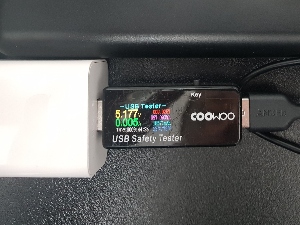
It took 9 hours and 44 minutes to get a full charge, the expected time. The charging speed was constant at 5V/2A. The power bank received 18,571 mAh / 97 Wh in total.
Recharging via RAVPower Fast Charger
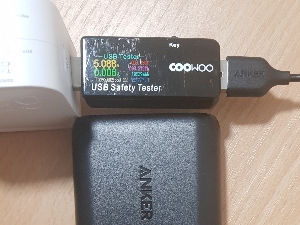
It took 9 hours and 50 minutes to get a full charge. Only a few minutes’ difference from the previous test. The charging speed was nearly the same. The power bank received 19,239 mAh / 98.3 Wh in total, which is closer to the full capacity of the power bank.
A roundup of input charging
The Anker PowerCore 20100 meets expectations. It doesn’t have cutting-edge technology, but 10 hours of overnight charging should be enough to get a full power bank.
Score
Design & Build
Dimension & Weight
Weight in ounces and grams
- 12.7 oz / 359 g
Measurement in inches and centimeters
- 6.5 x 2.4 x 0.9 in / 16.8 x 6.2 x 2.2 cm
It’s not the smallest power bank out there, but its size and weight are acceptable. It should easily slide into a backpack or purse pocket. Unfortunately, it’s too unwieldy for a pants pocket, unless you don’t mind excessive weight pressing on the side of your leg.
Design & Material
This power bank is very “Anker”. The company keeps its design consistent across its products, and this model follows the standard design: uniform color and minimalism.
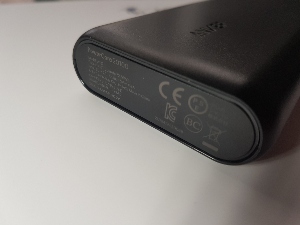
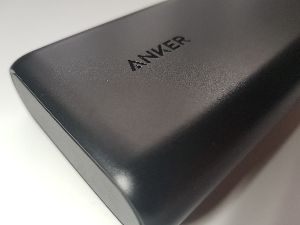
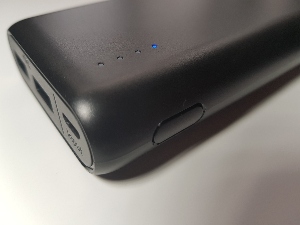
It’s available in four colors: black, white, red and blue. The tested device was black.
It’s built with four parts: one front, a back that meets on the sides along its whole length, and two short sides. It’s solid construction, everything stays firmly in place, no creaky parts. The material seems to be sturdy and should withstand a fall from a few feet onto a soft-ish floor. It might survive rock or hard ground, but the battery might be damaged.
The manufacturer guarantees a matte finish. Unfortunately, it attracts small smudges and fingerprints. It stays firmly in your hand, though.
Anker has mastered simplicity. On the front part, on the left side, is the Anker logo. In the upper-right corner, you’ll see 4 LED battery indicators. Each light represents 25% capacity. The lights are bright enough and don’t flash annoyingly. When the power bank is being recharged and reaches full charge, charging automatically stops, preventing damage to the power bank and charger. On the left hand-side is the power button.
On the upper side, above the LED lights, are three ports: one Micro USB for input charging and two USB-As for output charging.
Score
Technology
Ports
The device is equipped with two USB-A ports for output charging rated at 2.4A each (4.8A in total).
Both ports can be used simultaneously to charge two devices.
For recharging purposes, there is a Micro USB port rated at 5V/2A, the standard rate. Sadly, the device is not equipped with USB-C.
2 x UBS-A Output: 5V/2.4A (each)
Micro USB Input: 5V/2A
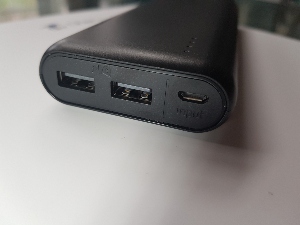
Tech
Anker usually offers the newest technology. Below is a list of the technologies used in this unit.
PowerIQ - fast charging technology
VoltageBoost - compensates for cable resistance by smoothing voltage output
MultiProtect safety system and high-quality LG battery cells ensure complete protection for you and your devices.
Score
Conclusion
Overall Opinion
The Anker PowerCore 20100 is a solid power bank that has nearly 27k reviews on Amazon (as of Jan 2021). If you’re looking for a big battery that allows you to charge phones over 4 times and two devices simultaneously, this is a good option. It might not always charge a phone at its highest speed, but the highly efficient battery makes up for this.